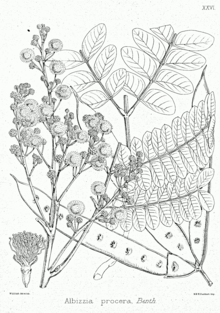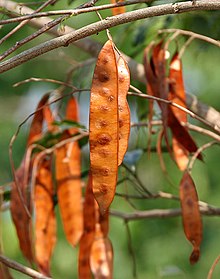Albizia procera
| Albizia procera | |
|---|---|

| |
| Scientific classification | |
| Kingdom: | Plantae |
| Clade: | Tracheophytes |
| Clade: | Angiosperms |
| Clade: | Eudicots |
| Clade: | Rosids |
| Order: | Fabales |
| Family: | Fabaceae |
| Subfamily: | Caesalpinioideae |
| Clade: | Mimosoid clade |
| Genus: | Albizia |
| Species: | A. procera
|
| Binomial name | |
| Albizia procera (Roxb.) Benth.
| |
Albizia procera, commonly known as white siris or karoi tree, is a species of large tree found natively in southeast Asia and India. It is most commonly found in open forests, but may also be found on the margins of rain forests and in monsoon and gallery forests.[2] It is considered an invasive species in South Africa.[3]
The genus name Albizia honors the Florentine naturalist Filippo del Albizzi, while the species name is derived from the Latin word 'procerus', meaning 'very tall or high'.[4]
Description
[edit]
A. procera is typically between 7 and 15 meters tall, although occasionally it reaches 30 meters in height.[3] It is deciduous, going leafless in the dry season (August–September).[2] The leaves are bi-pinnate, with 2–5 pairs of sub-opposite pinnae and a 10–30 centimeter rachis.[4] The bark is smooth and light-colored, exfoliating to reveal a reddish color underneath.[5] It produces sessile greenish-yellow flowers with long, threadlike white stamens, creating a puffball effect; these are borne on racemes 8–25 centimeters long.[6] The flowers give way to rich red or reddish-brown flattened pods containing 6–12 small, greenish-brown seeds.[7]
Uses
[edit]A. procera is cultivated for timber or as fuel in Asia, Africa and the Americas.[8] In India, the leaves are considered good fodder for animals such as cows, sheep, goats, and elephants.[7] The wood makes good charcoal, and the resin is a good substitute for gum arabic.[9] The leaves are said to be insecticidal, while the bark may be used to make fish poison.[10]
References
[edit]- ^ Barstow, M. (2019). "Albizia procera". IUCN Red List of Threatened Species. 2019: e.T60757956A60757961. doi:10.2305/IUCN.UK.2019-1.RLTS.T60757956A60757961.en. Retrieved 19 November 2021.
- ^ a b F.A.Zich; B.P.M.Hyland; T.Whiffen; R.A.Kerrigan (2020). "Albizia procera". Australian Tropical Rainforest Plants Edition 8 (RFK8). Centre for Australian National Biodiversity Research (CANBR), Australian Government. Retrieved 28 June 2021.
- ^ a b "Albizia procera (white siris)". CABI Invasive Species Compendium. November 19, 2019. Archived from the original on 2017-07-23. Retrieved April 27, 2021.
- ^ a b Orwa C, A Mutua, Kindt R , Jamnadass R, S Anthony. 2009 Agroforestree Database:a tree reference and selection guide version 4.0 (http://www.worldagroforestry.org/sites/treedbs/treedatabases.asp Archived 2009-01-16 at the Wayback Machine)
- ^ "Albizia procera (Roxb.)Benth". India Biodiversity Portal. Retrieved 2021-04-27.
- ^ "Winrock International - Albizia procera – white siris for reforestation and agroforestry". winrock.org. Retrieved 2021-04-27.
- ^ a b "A COMPREHENSIVE REVIEW OF ALBIZIA PROCERA (ROXB.) BENTH.-AN UPDATE | INTERNATIONAL JOURNAL OF PHARMACEUTICAL SCIENCES AND RESEARCH". Retrieved 2021-04-27.
- ^ "Albizia procera - Useful Tropical Plants". tropical.theferns.info. Retrieved 2020-03-01.
- ^ "Albizia procera – White Siris – Buy seeds at rarepalmseeds.com". www.rarepalmseeds.com. Retrieved 2021-04-27.
- ^ "Albizia procera". hort.purdue.edu. Retrieved 2021-04-27.
Text is available under the CC BY-SA 4.0 license; additional terms may apply.
Images, videos and audio are available under their respective licenses.

